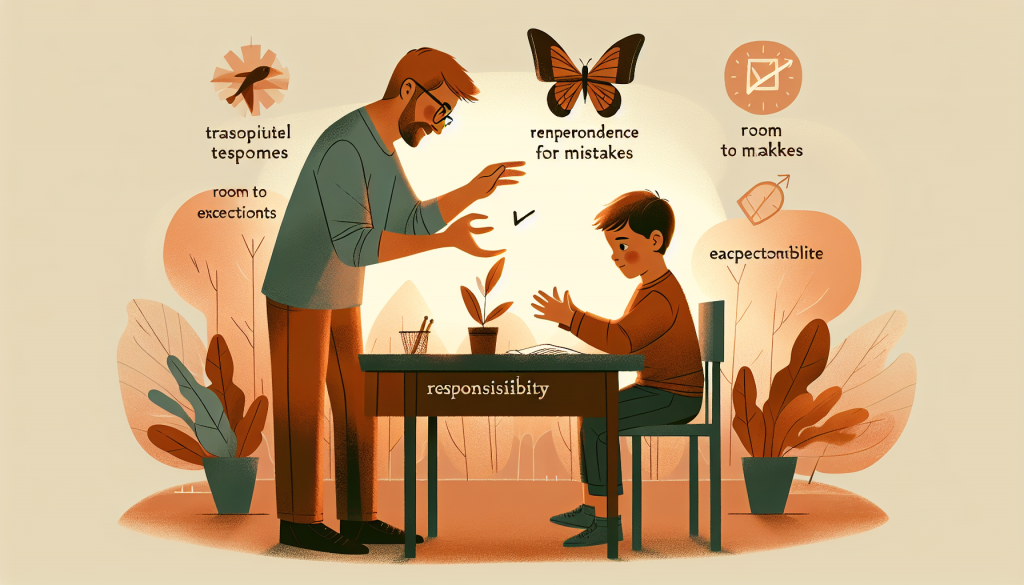“`html
Teaching Children Responsibility: A Guide for Parents
Introduction: Why Teaching Responsibility Matters
Responsibility is a cornerstone of personal growth and success. As parents, one of our most important roles is to teach our children how to embrace responsibility and become independent, confident individuals.
Helping children develop this essential life skill not only sets them up for success but also fosters resilience, problem-solving abilities, and self-discipline.
In this article, we’ll explore the importance of teaching responsibility, delve into the psychological principles behind it, and provide actionable strategies for parents.
Whether you’re a new parent or someone seeking to improve your interaction with your child, these tips will prove invaluable.
Main Points: Understanding Responsibility in Children
The Psychological Foundation of Responsibility
Teaching responsibility goes beyond chores or schoolwork. It’s about helping children develop a sense of autonomy, accountability, and self-expression, which are core psychological needs.
According to principles of cognitive-behavioral therapy (CBT), children need a safe environment where they can explore their capabilities and learn from their mistakes without fear of judgment.
Encouraging responsibility also satisfies a child’s need for safety (knowing they can rely on their parents) and autonomy (feeling capable of making their own decisions).
Children who take on responsibilities early tend to develop better problem-solving skills and emotional regulation.
The Benefits of Teaching Responsibility
- Increased Confidence: Completing tasks independently boosts a child’s self-esteem.
- Improved Problem-Solving Skills: Taking responsibility encourages children to think critically and find solutions.
- Stronger Relationships: Children who understand responsibility are more likely to collaborate and communicate effectively with others.
- Preparation for Adulthood: Teaching responsibility early prepares kids for the challenges of adult life.
Common Challenges Parents Face
It’s natural for parents to struggle with finding the balance between guiding their children and giving them the freedom to learn. Some common challenges include:
- Allowing children to fail without stepping in immediately.
- Knowing when to assign age-appropriate responsibilities.
- Managing resistance or refusal from children.
- Being consistent with expectations and consequences.
Recognizing these challenges is the first step in overcoming them. By addressing these obstacles with patience and consistency, parents can create an environment where child responsibility flourishes.
Practical Recommendations: How to Teach Responsibility
1. Start Early with Simple Tasks
Even toddlers can participate in small tasks like putting away toys or helping set the table. As children grow, gradually increase the complexity of their responsibilities.
Assigning age-appropriate chores helps build their sense of capability and accountability.
2. Set Clear Expectations
Children thrive when they understand what’s expected of them. Clearly explain tasks and provide step-by-step instructions if necessary. For example, instead of saying, “Clean your room,” you could say,
“Please pick up your toys, put your books on the shelf, and make your bed.”
3. Use Positive Reinforcement
Celebrate your child’s efforts and achievements, no matter how small. Positive reinforcement, such as verbal praise or a reward system, can motivate children to take ownership of their responsibilities.
For instance, saying, “I’m so proud of how you took care of that on your own!” reinforces their confidence and independence.
4. Be a Role Model
Children learn by example. Demonstrate responsibility in your own actions, whether it’s paying bills on time, keeping promises, or cleaning up after yourself.
When kids see their parents practicing what they preach, they’re more likely to adopt similar behaviors.
5. Allow Room for Mistakes
Mistakes are a natural part of learning. Instead of criticizing, use mistakes as teaching moments. Help your child reflect on what went wrong and how they can do better next time.
This approach builds resilience and problem-solving skills.
6. Create a Responsibility Chart
A visual chart can help children keep track of their tasks and progress. For younger children, use stickers or drawings to make it fun and engaging.
Older kids can use checklists or apps to stay organized. This not only teaches responsibility but also time management.
7. Encourage Decision-Making
Give your child opportunities to make choices, such as picking their outfit for the day or deciding what to prepare for dinner. Making decisions empowers children and helps them understand the consequences of their choices.
8. Be Consistent with Consequences
Consistency is key when teaching responsibility. If a child neglects their task, calmly enforce agreed-upon consequences. For example, if they forget to do their homework, they might lose screen time.
This helps them understand the importance of fulfilling their responsibilities.
Conclusion: Building a Foundation of Responsibility
Teaching children responsibility is a gradual process that requires patience, consistency, and empathy. By starting early, setting clear expectations, and providing opportunities for growth,
parents can help their children develop essential life skills. Responsibility not only prepares kids for future challenges but also builds their confidence, autonomy, and resilience.
Remember, small steps lead to big changes. Every moment spent guiding your child towards responsibility is an investment in their future.
As parents, we have the privilege of shaping our children into capable, confident, and compassionate individuals.
For more parenting advice and resources, explore our website and discover how to build stronger connections with your children.
“`

